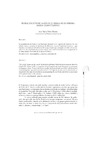Identificador persistente para citar o vincular este elemento:
https://accedacris.ulpgc.es/jspui/handle/10553/58956
| Campo DC | Valor | idioma |
|---|---|---|
| dc.contributor.author | Pérez Martín, Ana María | - |
| dc.date.accessioned | 2019-12-17T14:45:32Z | - |
| dc.date.available | 2019-12-17T14:45:32Z | - |
| dc.date.issued | 2007 | - |
| dc.identifier.issn | 0212-4130 | - |
| dc.identifier.other | Dialnet | - |
| dc.identifier.other | WoS | - |
| dc.identifier.uri | https://accedacris.ulpgc.es/handle/10553/58956 | - |
| dc.description.abstract | La pluralización de haber es un fenómeno frecuente en el español de Canarias. En este trabajo vamos a estudiar la incidencia de diferentes factores lingüísticos (como el rasgo humano o no humano del referente del complemento que acompaña al verbo o la reiteración de la idea de pluralidad) y sociales (edad, sexo y nivel sociocultural) en la aparición de la forma habían en el habla de la isla de El Hierro. | - |
| dc.description.abstract | This article focuses on the use of the Spanish verb form habían by native speakers from the island of El Hierro. I will try to analyse which linguistic and social factors serve to increase its frequency of use. Those social factors mediating the particular use of this verb form have to do with gender, age and sociocultural level. The linguistic factors, on the other hand, are related with the type of complement accompanying the verb form and with the recurrence of the plural mode in the sentence. | - |
| dc.language | spa | - |
| dc.relation.ispartof | Revista de Filología de la Universidad de La Laguna | - |
| dc.source | Revista de Filología de la Universidad de La Laguna [ISSN 0212-4130] (25), p. 505-514 | - |
| dc.subject | 57 Lingüística | - |
| dc.subject.other | Sociolingüística | - |
| dc.subject.other | Gramática | - |
| dc.subject.other | Pluralización | - |
| dc.subject.other | Sociolinguistic | - |
| dc.subject.other | Grammar | - |
| dc.subject.other | Plural form | - |
| dc.title | Pluralización de 'había' en el habla de El Hierro: datos cuantitativos | - |
| dc.title.alternative | Pluralization of had in the speech of El Hierro: quantitative data | - |
| dc.type | info:eu-repo/semantics/article | - |
| dc.type | Article | - |
| dc.identifier.isi | 000420238300048 | - |
| dc.identifier.url | http://dialnet.unirioja.es/servlet/articulo?codigo=2528456 | - |
| dc.description.lastpage | 514 | - |
| dc.identifier.issue | 25 | - |
| dc.description.firstpage | 505 | - |
| dc.relation.volume | 25 | - |
| dc.investigacion | Artes y Humanidades | - |
| dc.type2 | Artículo | - |
| dc.contributor.daisngid | 34943071 | - |
| dc.contributor.authordialnetid | 511864 | - |
| dc.identifier.dialnet | 2528456ARTREV | - |
| dc.description.numberofpages | 9 | - |
| dc.contributor.wosstandard | WOS:Martin, AMP | - |
| dc.date.coverdate | Febrero 2007 | - |
| dc.identifier.ulpgc | Sí | es |
| dc.description.sellofecyt | Sello FECYT | |
| dc.description.esci | ESCI | |
| dc.description.erihplus | ERIH PLUS | |
| item.fulltext | Con texto completo | - |
| item.grantfulltext | open | - |
| crisitem.author.dept | GIR Sociolingüística, fonética acústica y lingüística aplicada a la enseñanza | - |
| crisitem.author.dept | Departamento de Filología Hispánica, Clásica y de Estudios Árabes y Orientales | - |
| crisitem.author.orcid | 0000-0002-1810-4647 | - |
| crisitem.author.parentorg | Departamento de Filología Hispánica, Clásica y de Estudios Árabes y Orientales | - |
| crisitem.author.fullName | Pérez Martín, Ana María | - |
| Colección: | Artículos | |
Citas de WEB OF SCIENCETM
Citations
2
actualizado el 25-feb-2024
Visitas
25
actualizado el 14-oct-2023
Descargas
14
actualizado el 14-oct-2023
Google ScholarTM
Verifica
Comparte
Exporta metadatos
Los elementos en ULPGC accedaCRIS están protegidos por derechos de autor con todos los derechos reservados, a menos que se indique lo contrario.
